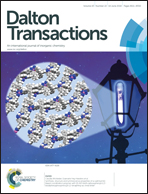Lanthanide anilido complexes: synthesis, characterization, and use as highly efficient catalysts for hydrophosphonylation of aldehydes and unactivated ketones†
Abstract
Lanthanide anilido complexes stabilized by the 2,6-diisopropylanilido ligand have been synthesized and characterized, and their catalytic activity for hydrophosphonylation reaction was explored. A reaction of anhydrous LnCl3 with 5 equivalents of LiNHPh-iPr2-2,6 in THF generated the heterobimetallic lanthanide–lithium anilido complexes (2,6-iPr2PhNH)5LnLi2(THF)2 [Ln = Sm(1), Nd(2), Y(3)] in good isolated yields. These complexes are well characterized by elemental analysis, IR, NMR (for complex 3) and single-crystal structure determination. Complexes 1–3 are isostructural. In these complexes, the lanthanide metal ion is five-coordinated by five nitrogen atoms from five 2,6-diisopropylanilido ligands to form a distorted trigonal bipyramidal geometry. The lithium ion is coordinated by two nitrogen atoms from two 2,6-diisopropylanilido ligands, and one oxygen atom from a THF molecule. It was found that these simple lanthanide anilido complexes are highly efficient for catalyzing hydrophosphonylation reactions of various aldehydes and unactivated ketones to generate α-hydroxyphosphonates in good to excellent yields (up to 99%) within a short time (5 min for aldehydes, 20 min for ketones). Furthermore, the mechanism of hydrophosphonylation reactions has also been elucidated via1H NMR monitoring of reaction.


 Please wait while we load your content...
Please wait while we load your content...